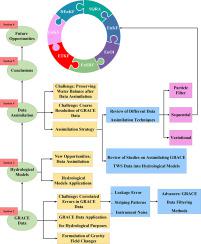Earth-Science Reviews ( IF 10.8 ) Pub Date : 2020-12-25 , DOI: 10.1016/j.earscirev.2020.103487 Samira Sadat Soltani , Behzad Ataie-Ashtiani , Craig T. Simmons

|
Global climate change and anthropogenic impacts lead to alterations in the water cycle, water resource availability and the frequency and intensity of floods and droughts. As a result, developing effective techniques such as hydrological modeling is essential to monitor and predict water storage changes. However, inaccuracies and uncertainties in different aspects of modeling, due to simplification of meteorological physical processes, data limitations and inaccurate climate forcing data limit the reliability of hydrological models. Satellite remote sensing datasets, especially Terrestrial Water Storage (TWS) data which can be obtained from Gravity Recovery and Climate Experiment (GRACE), provide a new and valuable source of data which can augment our understanding of the hydrologic cycle. Merging these new observations with hydrological models can effectively enhance the model performance using advanced statistical and numerical methods, which is known as data assimilation. Assimilation of new observations constrain the dynamics of the model based on uncertainties associated with both model and data, which can introduce missing water storage signals e.g., anthropogenic and extreme climate change effects. Assimilation of GRACE TWS data into hydrological models is a challenging task as provision should be made for handling the errors and then merging them with hydrological models using efficient assimilation techniques. The goal of this paper is to provide an in-depth overview of recent studies on assimilating GRACE TWS data into hydrological models and shed light on their limitations, challenges and progress. We present a comprehensive review of some challenges with GRACE TWS data assimilation into a hydrological model including GRACE TWS errors e.g., the correlated noise of high-frequency mass variations and spatial leakage errors, and how to work with GRACE TWS data errors to use the potential of GRACE TWS data as much as possible. We provide a review of the benefits and limitations of available data assimilation techniques with emphasis on the capability of sequential methods for hydrological applications.
中文翻译:

审查将GRACE陆地储水数据纳入水文模型:进展,挑战和机遇
全球气候变化和人为影响导致水循环,水资源可用性以及洪水和干旱的频率和强度发生变化。因此,开发有效的技术(例如水文模型)对于监控和预测储水量的变化至关重要。但是,由于气象物理过程的简化,数据局限性和不正确的气候强迫数据,在建模的不同方面都存在误差和不确定性,这限制了水文模型的可靠性。卫星遥感数据集,尤其是可以从重力恢复和气候实验(GRACE)获得的陆地水存储(TWS)数据,提供了一种新的有价值的数据来源,可以增进我们对水文循环的理解。将这些新观测值与水文模型合并可以使用先进的统计和数值方法(称为数据同化)有效地提高模型性能。基于与模型和数据相关的不确定性,对新观测值的吸收会限制模型的动态性,这可能会引入缺少的蓄水信号,例如人为和极端气候变化影响。将GRACE TWS数据同化到水文模型中是一项艰巨的任务,因为应该规定要处理的错误,然后使用有效的同化技术将其与水文模型合并。本文的目的是提供有关GRACE TWS数据纳入水文模型的最新研究的深入概述,并阐明它们的局限性,挑战和进展。我们对GRACE TWS数据同化到水文模型中的一些挑战进行了全面回顾,包括GRACE TWS错误,例如,高频质量变化和空间泄漏错误的相关噪声,以及如何处理GRACE TWS数据错误以利用潜在的尽可能多地收集GRACE TWS数据。我们对可用数据同化技术的优点和局限性进行了回顾,重点介绍了水文应用顺序方法的功能。











































 京公网安备 11010802027423号
京公网安备 11010802027423号